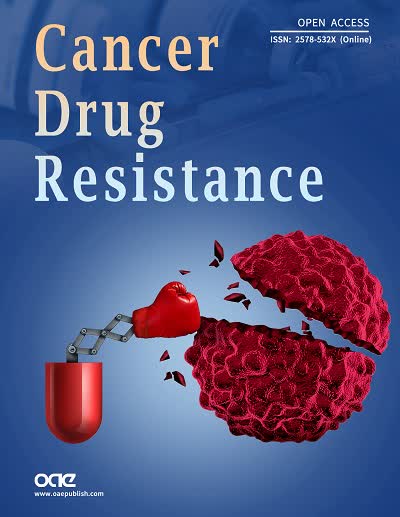REFERENCES
1. Deweese JE, Osheroff N. The DNA cleavage reaction of topoisomerase II: wolf in sheep’s clothing. Nucleic Acids Res 2009;37:738-48.
2. Vos SM, Tretter EM, Schmidt BH, Berger JM. All tangled up: how cells direct, manage and exploit topoisomerase function. Nat Rev Mol Cell Biol 2011;12:827-41.
3. Chen SH, Chan NL, Hsieh TS. New mechanistic and functional insights into DNA topoisomerases. Annu Rev Biochem 2013;82:139-70.
4. Pommier Y, Sun Y, Huang SN, Nitiss JL. Roles of eukaryotic topoisomerases in transcription, replication and genomic stability. Nat Rev Mol Cell Biol 2016;17:703-21.
6. Pommier Y, Marchand C. Interfacial inhibitors: targeting macromolecular complexes. Nat Rev Drug Discov 2011;11:25-36.
8. Delgado JL, Hsieh CM, Chan NL, Hiasa H. Topoisomerases as anticancer targets. Biochem J 2018;475:373-98.
9. Economides MP, McCue D, Borthakur G, Pemmaraju N. Topoisomerase II inhibitors in AML: past, present, and future. Expert Opin Pharmacother 2019;20:1637-44.
10. Edwardson DW, Narendrula R, Chewchuk S, Mispel-Beyer K, Mapletoft JPJ, et al. Role of drug metabolism in the cytotoxicity and clinical efficacy of anthracyclines. Curr Drug Metab 2015;16:412-26.
11. Shanbhag S, Ambinder RF. Hodgkin lymphoma: a review and update on recent progress. CA Cancer J Clin 2018;68:116-32.
12. National Comprehensive Cancer Network. NCCN Clinical Practice Guidelines in Oncology: Small Cell Lung Cancer (Version 1.2020). Available from: https://www.nccn.org/professionals/physician_gls/pdf/sclc.pdf [Last accessed on 19 Feb 2020].
13. Zhao H, Ren D, Liu H, Chen J. Comparison and discussion of the treatment guidelines for small cell lung cancer. Thorac Cancer 2018;9:769-74.
14. Greene J, Hennessy B. The role of anthracyclines in the treatment of early breast cancer. J Oncol Pharm Pract 2015;21:201-12.
15. Blum JL, Flynn PJ, Yothers G, Asmar L, Geyer CE Jr, et al. Anthracyclines in early breast cancer: the ABC Trials-USOR 06-090, NSABP B-46-I/USOR 07132, and NSABP B-49 (NRG Oncology). J Clin Oncol 2017;35:2647-55.
16. Owattanapanich W, Owattanapanich N, Kungwankiattichai S, Ungprasert P, Kuchutrakool T. Efficacy and toxicity of idarubicin versus high-dose daunorubicin for induction chemotherapy in adult acute myeloid leukemia: a systematic review and meta-analysis. Clin Lymphoma Myeloma Leuk 2018;18:814-21.e3.
17. National Comprehensive Cancer Network. NCCN Clinical Practice Guidelines in Oncology: Acute Myeloid Leukemia (Version 2.2020). Available from: https://www.nccn.org/professionals/physician_gls/pdf/aml.pdf [Last accessed on 19 Feb 2020].
18. Burgess DJ, Doles J, Zender L, Xue W, Ma B, et al. Topoisomerase levels determine chemotherapy response in vitro and in vivo. Proc Natl Acad Sci U S A 2008;105:9053-58.
19. Pilati P, Nitti D, Mocellin S. Cancer resistance to type II topoisomerase inhibitors. Curr Med Chem 2012;19:3900-06.
20. Ganapathi RN, Ganapathi MK. Mechanisms regulating resistance to inhibitors of topoisomerase II. Front Pharmacol 2013;4:89.
21. Capelôa T, Benyahia Z, Zampieri LX, Blackman MCNM, Sonveaux P. Metabolic and non-metabolic pathways that control cancer resistance to anthracyclines. Semin Cell Dev Biol 2020;98:181-91.
22. Zahreddine H, Borden KL. Mechanisms and insights into drug resistance in cancer. Front Pharmacol 2013;4:28.
23. Cree IA, Charlton P. Molecular chess? Hallmarks of anti-cancer drug resistance. BMC Cancer 2017;17:10.
24. Lee Y, Rio DC. Mechanisms and regulation of alternative pre-mRNA splicing. Annu Rev Biochem 2015;84:291-323.
25. Boutz PL, Bhutkar A, Sharp PA. Detained introns are a novel, widespread class of post-transcriptionally spliced introns. Genes Dev 2015;29:63-80.
26. Wong JJ, Au AY, Ritchie W, Rasko JE. Intron retention in mRNA: no longer nonsense: known and putative roles of intron retention in normal and disease biology. Bioessays 2015;38:41-9.
27. Kurosaki T, Maquat LE. Nonsense-mediated mRNA decay in humans at a glance. J Cell Sci 2016;129:461-7.
28. Li Y, Bor YC, Fitzgerald MP, Lee KS, Rekosh D, et al. An NXF1 mRNA with a retained intron is expressed in hippocampal and neocortical neurons and is translated into a protein that functions as an Nxf1 cofactor. Mol Biol Cell 2016;27:3903-12.
29. Uzor S, Zorzou P, Bowler E, Porazinski S, Wilson I, et al. Autoregulation of the human splice factor kinase CLK1 through exon skipping and intron retention. Gene 2018;670:46-54.
30. Shoubridge C, Jackson M, Grinton B, Berkovic SF, Scheffer IE, et al. Splice variant in ARX leading to loss of C-terminal region in a boy with intellectual disability and infantile onset developmental and epileptic encephalopathy. Am J Med Genet A 2019;179:1483-90.
31. Wang C, Buolamwini JK. A novel RNA variant of human concentrative nucleoside transporter 1 (hCNT1) that is a potential cancer biomarker. Exp Hematol Oncol 2019;8:18.
32. Harker WG, Slade DL, Parr RL, Holguin MH. Selective use of an alternative stop codon and polyadenylation signal within intron sequences leads to a truncated topoisomerase II alpha messenger RNA and protein in human HL-60 leukemia cells selected for resistance to mitoxantrone. Cancer Res 1995;55:4962-71.
33. Yu Q, Mirski SE, Sparks KE, Cole SP. Two COOH-terminal truncated cytoplasmic forms of topoisomerase II alpha in a VP-16-selected lung cancer cell line result from partial gene deletion and alternative splicing. Biochemistry 1997;36:5868-77.
34. Mo YY, Beck WT. Heterogeneous expression of DNA topoisomerase II alpha isoforms in tumor cell lines. Oncol Res 1997;9:193-204.
35. Kanagasabai R, Serdar L, Karmahapatra S, Kientz CA, Ellis J, et al. Alternative RNA processing of topoisomerase iialpha in etoposide-resistant human leukemia K562 cells: intron retention results in a novel c-terminal truncated 90-kDa isoform. J Pharmacol Exp Ther 2017;360:152-63.
36. Kanagasabai R, Karmahapatra S, Kientz CA, Yu Y, Hernandez VA, et al. The novel C-terminal truncated 90-kDa isoform of topoisomerase IIalpha (TOP2alpha/90) is a determinant of etoposide resistance in K562 leukemia cells via heterodimerization with the TOP2alpha/170 isoform. Mol Pharmacol 2018;93:515-25.
37. Lang AJ, Mirski SE, Cummings HJ, Yu Q, Gerlach JH, et al. Structural organization of the human TOP2A and TOP2B genes. Gene 1998;221:255-66.
38. Tsai-Pflugfelder M, Liu LF, Liu AA, Tewey KM, Whang-Peng J, et al. Cloning and sequencing of cDNA encoding human DNA topoisomerase II and localization of the gene to chromosome region 17q21-22. Proc Natl Acad Sci U S A 1988;85:7177-81.
39. Dong KC, Berger JM. Structural basis for gate-DNA recognition and bending by type IIA topoisomerases. Nature 2007;450:1201-5.
40. Wendorff TJ, Schmidt BH, Heslop P, Austin CA, Berger JM. The structure of DNA-bound human topoisomerase II a: conformational mechanisms for coordinating inter-subunit interactions with DNA cleavage. J Mol Biol 2012;424:109-24.
41. Frère V, Sourgen F, Monnot M, Troalen F, Fermandjian S. A peptide fragment of human DNA topoisomerase II alpha forms a stable coiled-coil structure in solution. J Biol Chem 1995;270:17502-07.
42. Berger JM, Gamblin SJ, Harrison SC, Wang JC. Structure and mechanism of DNA topoisomerase II. Nature 1996;379:225-22.
43. Frère-Gallois V, Krebs D, Scala D, Troalen F, Fermandjian S. Peptide fragments of DNA topoisomerase II with helix-forming and coiled-coil-forming properties act as inhibitors of the enzyme. Eur J Biochem 1997;249:142-8.
44. Kroll DJ. Homologous and heterologous protein-protein interactions of human DNA topoisomerase II alpha. Arch Biochem Biophys 1997;345:175-84.
45. Bjergbaek L, Jensen S, Westergaard O, Andersen AH. Using a biochemical approach to identify the primary dimerization regions in human DNA topoisomerase II alpha. J Biol Chem 1999;274:26529-36.
46. Mirski SE, Gerlach JH, Cummings HJ, Zirngibl R, Greer PA, et al. Bipartite nuclear localization signals in the C terminus of human topoisomerase II alpha. Exp Cell Res 1997;237:452-5.
47. Mirski SE, Gerlach JH, Cole SP. Sequence determinants of nuclear localization in the alpha and beta isoforms of human topoisomerase II. Exp Cell Res 1999;251:329-39.
48. Kim D, Langmead B, Salzberg SL. HISAT: a fast spliced aligner with low memory requirements. Nat Methods 2015;12:357-60.
49. Robinson JT, Thorvaldsdottir H, Winckler W, Guttman M, Lander ES, et al. Integrative genomics viewer. Nat Biotechnol 2011;29:24-6.
50. Harker WG, Slade DL, Dalton WS, Meltzer PS, Trent JM. Multidrug resistance in mitoxantrone-selected HL-60 leukemia cells in the absence of P-glycoprotein overexpression. Cancer Res 1989;49:4542-9.
51. Harker WG, Slade DL, Drake FH, Parr RL. Mitoxantrone resistance in HL-60 leukemia cells: reduced nuclear topoisomerase II catalytic activity and drug-induced DNA cleavage in association with reduced expression of the topoisomerase II beta isoform. Biochemistry 1991;30:9953-61.
52. Lane AB, Giménez-Abián JF, Clarke DJ. A novel chromatin tether domain controls topoisomerase IIα dynamics and mitotic chromosome formation. J Cell Biol 2013;203:471-86.
53. Feldhoff PW, Mirski SE, Cole SP, Sullivan DM. Altered subcellular distribution of topoisomerase II alpha in a drug-resistant human small cell lung cancer cell line. Cancer Res 1994;54:756-62.
54. Mirski SE, Cole SP. Cytoplasmic localization of a mutant M(r) 160,000 topoisomerase II alpha is associated with the loss of putative bipartite nuclear localization signals in a drug-resistant human lung cancer cell line. Cancer Res 1995;55:2129-34.
55. Ritke MK, Yalowich JC. Altered gene expression in human leukemia K562 cells selected for resistance to etoposide. Biochem Pharmacol 1993;46:2007-20.
56. Ritke MK, Roberts D, Allan WP, Raymond J, Bergoltz VV, et al. Altered stability of etoposide-induced topoisomerase Il-DNA complexes in resistant human leukemia K562 cells. Br J Cancer 1994;69:687-97.
57. Zwelling LA, Hinds M, Chan D, Mayes J, Sie KL, et al. Characterization of an amsacrine-resistant line of human leukemia cells. Evidence for a drug-resistant form of topoisomerase II. J Biol Chem 1989;264:16411-20.
58. Christie M, Chang CW, Róna G, Smith KM, Stewart AG, et al. Structural biology and regulation of protein import into the nucleus. J Mol Biol 2016;428:2060-90.
59. Gardiner LP, Roper DI, Hammonds TR, Maxwell A. The N-terminal domain of human topoisomerase II alpha is a DNA-dependent ATPase. Biochemistry 1998;37:16997-7004.
60. Campbell S, Maxwell A. The ATP-operated clamp of human DNA topoisomerase II alpha: hyperstimulation of ATPase by “piggy-back” binding. J Mol Biol 2002;320:171-88.
61. Hu T, Sage H, Hsieh TS. ATPase domain of eukaryotic DNA topoisomerase II. Inhibition of ATPase activity by the anti-cancer drug bisdioxopiperazine and ATP/ADP-induced dimerization. J Biol Chem 2002;277:5944-51.
62. Austin CA, Lee KC, Swan RL, Khazeem MM, Manville CM, et al. TOP2B: the first thirty years. Int J Mol Sci 2018;19:E2765.
63. Cowell IG, Austin CA. Do transcription factories and TOP2B provide a recipe for chromosome translocations in therapy-related leukemia? Cell Cycle 2012;11:3143-4.











